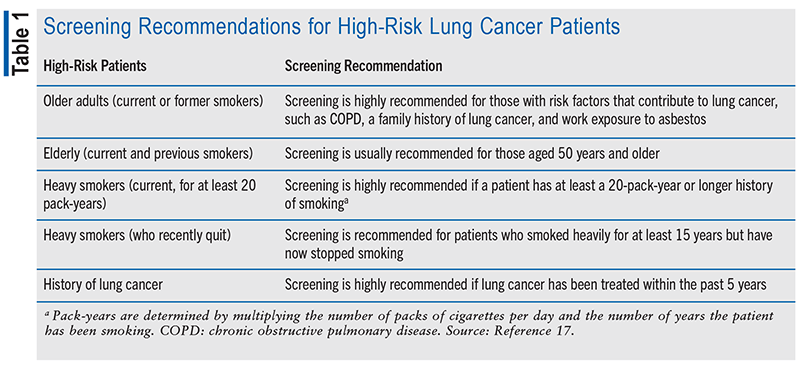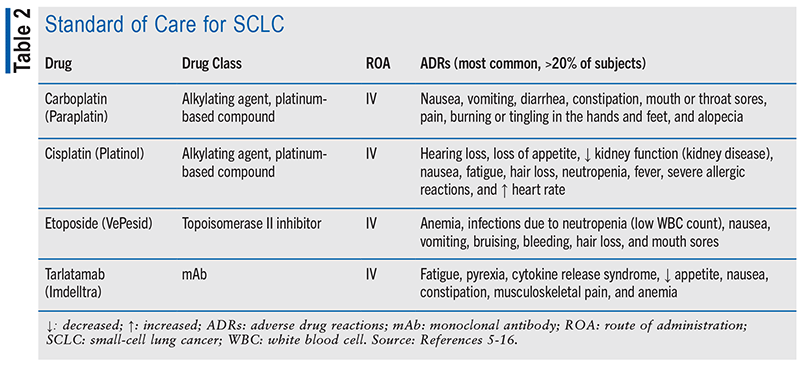US Pharm. 2024;49(7):44-46.
ABSTRACT: Small-cell lung cancer (SCLC) is a challenging cancer type with low survival rates despite extensive research efforts. SCLC is characterized by rapid growth and is strongly linked to smoking. Diagnosis often occurs at an advanced stage, with limited treatment options available, including surgery, chemotherapy, and immunotherapy. Risk factors include smoking, exposure to carcinogens, and genetic mutations. Screening methods aid in early detection, while prevention focuses on avoiding tobacco smoke and environmental toxins. Despite current treatment challenges, ongoing clinical drug trials, such as tarlatamab, offer hope for improved outcomes in recurrent SCLC. However, further research is necessary to enhance access to effective therapies and enhance survival rates for SCLC patients.
Of all the forms of cancer in the United States, lung cancer ranks as the third most common. The two types of lung cancer are small-cell lung cancer (SCLC) and non-SCLC. When SCLC was first medically documented in the lungs, researchers described it as resembling oat-like grains.1 Around 10% to 15% of all lung cancers are SCLC.2 The standard range of care for SCLC includes surgery, chemotherapy, radiation therapy, immunotherapy, laser therapy, and endoscopic stent placement. Even with over 30 years of research, treatment success remains quite low. The needle has not moved very far with respect to drug development in treating this deadly disease. Additionally, the survival rate is very low.
SCLC is a rare and rapidly growing type of cancer that develops in the tissues of the lungs. There is a high proliferation and mutation rate in lung cancer, making it difficult to treat. The primary correlating risk factor for developing SCLC is smoking; however, nonsmokers can develop lung cancer if they are exposed to secondhand smoke. In addition, being exposed to workplace environmental carcinogens increases lung cancer risk.2,3
The hallmark signs of SCLC are chronic coughing and persistent shortness of breath, which is similar to chronic obstructive pulmonary disease (COPD). To differentiate between COPD and classify which stage the SCLC has progressed to, diagnostic tests and screening procedures are core to the standard of care. Pulmonologists and oncologists can order diagnostic screening tests such as CT scans, positron emission tomography (PET) scans, biopsy, bronchoscopy, and endobrachial ultrasound. CT scans produce three-dimensional, cross-sectional images by using x-rays. If doctors suspect that the cancer has metastasized or has grown rapidly, they will order a PET scan, which consists of a special camera to produce highly detailed images of any cancerous growth. The prior two imaging studies of CT scans and PET scans can only be confirmed with a biopsy, wherein pathologists study the extracted cancerous tissue under a microscope to determine the size and shape of the cancer cells and if they are indeed lung cancer cells. A bronchoscopy may be performed to look at or remove cancer cells with a camera-guided tube, known as a bronchoscope, after it is inserted via the nose or mouth and into the airways. After the SCLC staging, practitioners can determine an appropriate treatment plan. Unfortunately, once SCLC is detected and has been diagnosed, it is already in an advanced stage. In the advanced stage of SCLC, there is a low chance of survival.4
Stages of SCLC
SCLC is classified into three stages: limited-stage SCLC (LS-SCLC), extensive-stage SCLC (ES-SCLC), and recurrent SCLC (RSCLC). Approximately 30% of patients with SCLC are in the early stages of disease progression.4 LS-SCLC occurs when the cancer is confined within one part of the chest cavity. ES-SCLC occurs when the cancer has metastasized to other parts of the body, such as the lung, bone, or brain. ES-SCLC is usually not curable and is managed with palliative care to prolong a patient’s life and to reduce symptoms associated with the disease.4 When the cancer continues to grow during therapy or comes back after the patient is treated, it is known as RSCLC.
Risk Factors
Smoking is the primary risk factor for developing SCLC, even though nonsmokers can still develop this form of lung cancer (see TABLE 1). Other causes that contribute to lung cancer are environmental cancer-causing agents known as carcinogens. Carcinogens often increase lung cancer risk from occupational work exposure. Compounds in the environment that are carcinogens identified by the National Toxicology Program are arsenic, aflatoxins, asbestos, benzene, beryllium, cadmium, coal tar, ethylene oxide, formaldehyde, indoor emission from household combustion of coal, mineral oils, nickel, radon, secondhand tobacco smoke, soot, sulfuric acid, thorium, wood dust, and vinyl chloride.3 A family history of lung cancer also increases the risk of developing SCLC.15

There is a genetic component that contributes to the increased risk of lung cancer development. In a comprehensive study in which 110 cancer tissues from patients with SCLC were genetically sequenced, most of the tumors were found to have biallelic inactivation of TP53 and RB1, sometimes through complex genomic rearrangements. Two tumors with wild-type RB1 were documented with a mutational event wherein thousands of clustered chromosomes were rearranged. This process is called chromothripsis. When the TP53 and RB1 tumor-suppressor genes are deactivated, this inactivation will lead to the development of SCLC disease. Thus, a genetic diagnostic marker for SCLC is the inactivation of the TP53 and RB1 tumor-suppressor genes. Somatic genomic mutations of TP73, which created an oncogenic version of the TP73 gene, were also found. Kinase gene mutations were also found, and inactivation of NOTCH family genes occurred in one-quarter of the SCLC cases sequenced. This study discovered crucial biological steps, providing an important roadmap for the development of potential therapeutic targets for therapy.9,10,16
Prevention
It is important to be proactive in lowering the chances of developing cancer. Cancer risk factors are actions or lifestyle habits that increase the risk of developing cancer. Cancer-protective factors are actions or lifestyle habits to be undertaken to decrease the risk of developing cancer. Unfortunately, some risk factors cannot be avoided, such as inheriting certain genes that increase the risk factor for the development of SCLC. Avoiding tobacco smoke is the single most effective protective factor, and avoiding exposure to carcinogens in the work environment is also important.2,3
Screening and Diagnosis
Screening is generally reserved for those patients who are at the highest risk for developing lung cancer.17 Screening methods help practitioners look for the cancer before the patient has any symptoms. These tests and procedures begin with taking laboratory samples from tissue, blood, and urine. The results from these samples help practitioners create a treatment plan and monitor disease progression. A chest x-ray can also be done to take pictures of the chest cavity, with any white-gray masses that show in the images to be diagnosed by a radiologist. A CT scan of the brain, chest, and abdomen is also conducted to monitor disease progression if the cancer is isolated in one area of the chest (LS-SCLC) or has metastasized (ES-SCLC). A biopsy is performed in which the doctor removes a small piece of tissue that contains cancerous cells that will be studied under a microscope. The cancer cells are assessed by a team of oncologists, pathologists, and other practitioners. These screening tests include low-dose CT scans, chest x-rays, and/or sputum cytology screenings.6
Treatment
Treatment resistance and recurrence of the disease make lung cancer challenging to treat. Recurrence occurs after the cancer is treated and the cancer cells reemerge. SCLC aggressively affects both lungs, and surgery may be used in addition to chemotherapy and radiation. During surgery, the goal is to remove as many cancer cells as possible.7 The remaining cells are killed off through chemotherapy and/or radiation therapy. Chemotherapy is the process of using highly hazardous and specialized drugs—with many adverse side effects—to stop the division and growth of cancer cells.2,6,7 Radiation therapy is used to prevent the spread of cancer cells to the brain after there is a full response from chemotherapy.
The current standard of care for LS-SCLC is chemotherapy with a platinum agent (cisplatin or carboplatin) and etoposide (see TABLE 2).6 ES-SCLC is usually treated with palliative care due to the aggressive and metastatic nature of the disease. ES-SCLC has the highest mortality rate, and the chance of survival is low.

A novel targeted immunotherapy known as tarlatamab demonstrates effectiveness in certain individuals with SCLC. Tarlatamab is a bispecific T-cell–engaging monoclonal antibody that targets delta-like ligand 3 and CD3 to treat ES-SCLC. Tarlatamab was given to test subjects every 2 weeks at a dosage of 10 mg or 100 mg.16 Among the patients, the objective of tumor shrinkage was met in 40% (97.5% CI, 29-52) of the test subjects in the 10-mg group and in 32% (97.5% CI, 21-44) of those in the 100-mg group.16 For patients who had met the objective response of tumor shrinkage, disease progression did not occur for 6 months in 59% of the cases (40 of 68 patients).16 The overall survival rate was 9 months in approximately two out of three patients in the trial.16
Conclusion
Lung cancer is a leading cause of death globally. The survival rate remains very low even with 3 decades of research. Screening is performed to detect the early stages of SCLC. Early detection increases the 5-year survival rate in approximately 60% of patients. SCLC is classified into “stages”—LS-SCLC, ES-SCLC, and RSCLC. There are limited treatment options when the disease has progressed into ES-SCLC. Clinical trials are being conducted to offer patients a higher chance of survival, especially those with ES-SCLC. More resources and clinical research are needed to offer patients better access to novel therapeutic treatments.
REFERENCES
1. Barnard WG. The nature of the “oat-celled sarcoma” of the mediastinum. J Pathol. 1926;29:241-244.
2. American Cancer Society. Cancer facts & figures 2024. www.cancer.org/content/dam/cancer-org/research/cancer-facts-and-statistics/annual-cancer-facts-and-figures/2024/2024-cancer-facts-and-figures-acs.pdf. Accessed April 18, 2024.
3. National Cancer Institute. Cancer-causing substances in the environment. June 17, 2022. www.cancer.gov/about-cancer/causes-prevention/risk/substances. Accessed June 10, 2024.
4. Farago AF, Keane FK. Current standards for clinical management of small cell lung cancer. Transl Lung Cancer Res. 2018;7(1):69-79.
5. Cheng Y, Yang R, Chen J, et al. Benmelstobart with anlotinib plus chemotherapy as first-line therapy for ES-SCLC: a randomized, double-blind, phase III trial. Singapore: 2023 World Conference on Lung Cancer. Abstract OA01.03. Presented September 10, 2023.
6. National Cancer Institute. Lung cancer screening (PDQ®)–patient version. May 24, 2024. www.cancer.gov/types/lung/patient/lung-screening-pdq. Accessed June 10, 2024
7. CDC. Treatment of lung cancer. February 20, 2024. www.cdc.gov/lung-cancer/treatment/index.html. Accessed June 10, 2024.
8. Rudin CM, Brambilla E, Faivre-Finn C, Sage J. Small-cell lung cancer. Nat Rev Dis Primers. 2021;7(1):3.
9. George J, Lim JS, Jang SJ, et al. Comprehensive genomic profiles of small cell lung cancer. Nature. 2015;524(7563):47-53.
10. Hasskarl J. Everolimus. Recent Results Cancer Res. 2018;211:101-123.
11. Sun JM, Kim JR, Do IG, et al. A phase-1b study of everolimus plus paclitaxel in patients with small-cell lung cancer. Br J Cancer. 2013;109(6):1482-1487.
12. von Pawel J, Schiller JH, Shepherd FA, et al. Topotecan versus cyclophosphamide, doxorubicin, and vincristine for the treatment of recurrent small-cell lung cancer. J Clin Oncol. 1999;17(2):658-667.
13. Ardizzoni A. Topotecan in the treatment of recurrent small cell lung cancer: an update. Oncologist. 2004;9(Suppl 6):4-13.
14. Olmedo ME, Forster M, Moreno V, et al. Efficacy and safety of lurbinectedin and doxorubicin in relapsed small cell lung cancer. Results from an expansion cohort of a phase I study. Invest New Drugs. 2021;39(5):1275-1283.
15. Wang Q, Gümüş ZH, Colarossi C, et al. SCLC: epidemiology, risk factors, genetic susceptibility, molecular pathology, screening, and early detection. J Thorac Oncol. 2023;18(1):31-46.
16. Ahn MJ, Cho BC, Felip E, et al. Tarlatamab for patients with previously treated small-cell lung cancer. N Engl J Med. 2023;389(22):2063-2075.
17. CDC. Screening for lung cancer. February 23, 2024. www.cdc.gov/lung-cancer/screening. Accessed June 10, 2024.
The content contained in this article is for informational purposes only. The content is not intended to be a substitute for professional advice. Reliance on any information provided in this article is solely at your own risk.
To comment on this article, contact rdavidson@uspharmacist.com.






